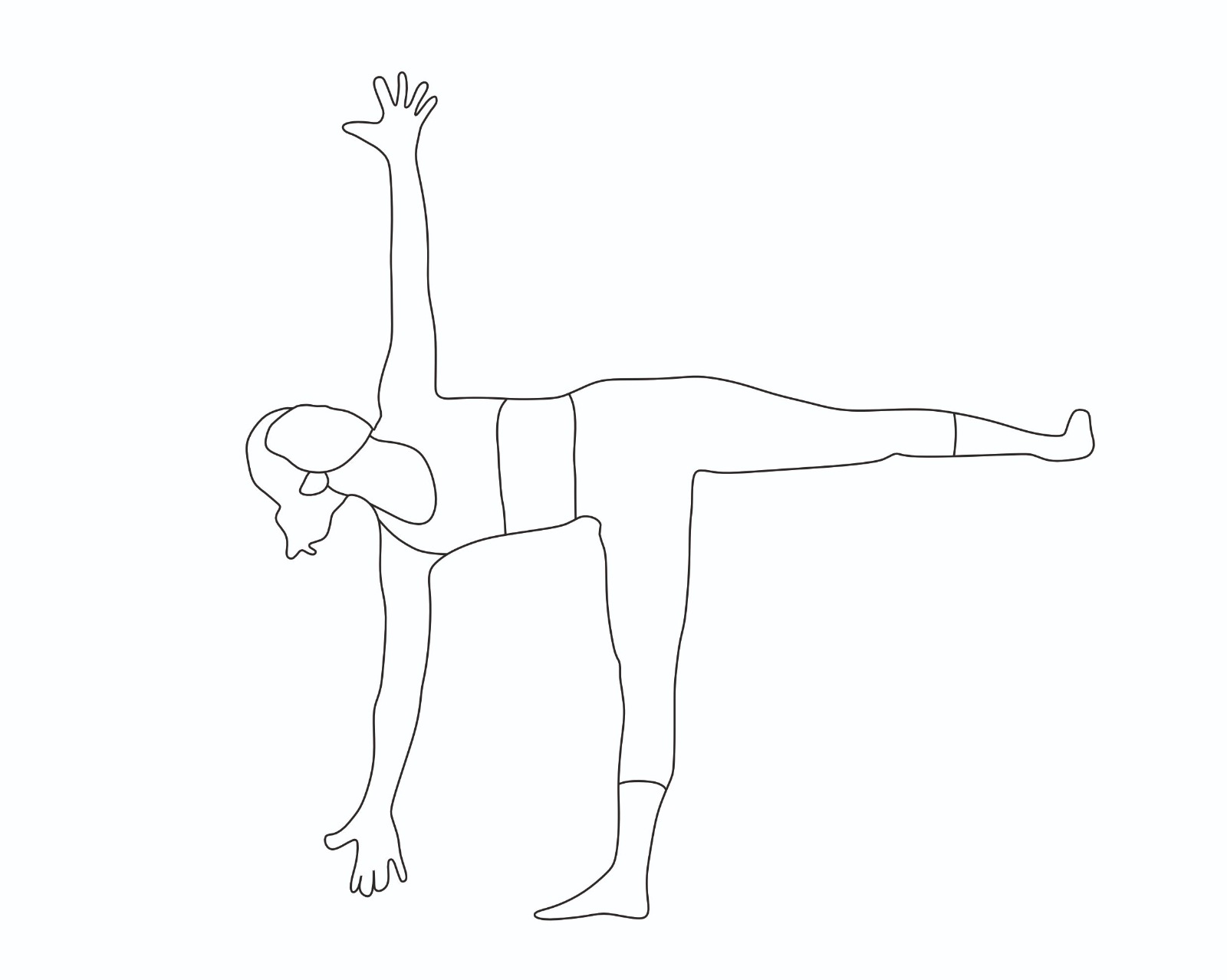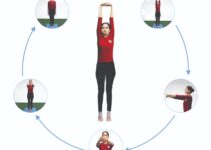Half Moon Pose Yoga (Ardha Chandrasana) is a challenging yoga pose that requires balance and energy and is known for calmness and cooling. The posture is also intense. In Sanskrit, it is called Ardha Chandrasana and pronounced as ‘are-dah chan-DRAHS-anna’ wherein ardha = half, Chandra = glittering, and asana means yoga pose. It targets the entire body.

Half Moon Pose step-by-step
- Starting position: Begin in Utthita Trikonasana (Extended Triangle Pose) with your left foot forward and your right foot back, keeping your feet approximately three to four feet apart.
- Prepare for the transition: Bring your right hand to your right hip as you transition into Half Moon Pose.
- Shift your weight: Shift your weight into your left foot (the front foot in this case) while maintaining a solid engagement of your core muscles.
- Place your hand on the floor or block: Reach your left hand slightly forward and place it on the mat or a yoga block directly beneath your left shoulder.
- Lift your back leg: Slowly lift your right leg (the back leg) off the floor. Keep lifting the leg until your right thigh is parallel to the floor. Engage your glutes and thigh muscles to maintain the raised position.
- Open your chest and hips: Begin to open your chest and hips to the right side. Your right hip should stack on top of your left hip. Extend your right arm toward the ceiling, creating a straight line from your left hand through your left shoulder to your right hand.
- Gaze and balance: Keep your gaze on the floor for better proportion, or slowly turn your head to look at your right hand, depending on your comfort and balance. Maintain a slight micro-bend in your left knee to avoid hyperextension and keep your leg strong.
Precautions
If you have a tight chest or hips, do some hip-opening exercises before practising this pose.
In a balancing issue, it is better to keep your gaze ahead.
Focus on maintaining balance, alignment, and a smooth transition in and out of the pose.
The standing knee shouldn’t be locked.
The raised leg should be in line with the hip.
Safety and contraindications
Ardha Chandrasana shouldn’t be performed in the following conditions:
Arthritis
Injuries in legs, hips, thighs and shoulders
Benefits
It helps to improve balance and counteracts the effects of prolonged sitting.
It strengthens the core muscles.
It strengthens the thighs, groin, ankles, hamstrings and glutes.
Beginner Tips for Half-Moon Pose
Here are some beginner tips to help you practice Half Moon Pose safely and effectively:
Warm-up: Start with a gentle introduction to prepare your body, especially your hips, hamstrings, and core. Sun Salutations (Surya Namaskar) or other hip-opening stretches can be beneficial.
Use props: If you’re new to Half Moon Pose or have balance issues, consider using yoga blocks to support your hand on the floor. This can make it easier to find stability and maintain the pose.
Proper alignment: Begin standing, feet hip-width apart and toes pointing forward. Shift your weight onto one foot and engage your core muscles. Keep the vertical knee slightly bent to avoid hyperextension. The lifted leg should be parallel to the floor, with toes pointing forward or slightly down. Maintain a straight line from your head to your lifted heel.
Gaze: Focus your eye on a fixed point in front of you to help with balance and concentration. This is a crucial aspect of many yoga poses, including Half Moon.
Engage your core: Activate your abdominal muscles to stabilise your pelvis and prevent your lower back from arching. A strong body will help you maintain balance.
Hips and shoulders: Keep your hips and shoulders stacked on each other as you open up to the side. Imagine your body between two panes of glass to maintain proper alignment.
Start with a low lift: Don’t worry about lifting your leg too high when first learning the pose. Focus on finding balance and stability with a lower leg lift, gradually working your way up.
Use the wall: If balancing is challenging, practice near a border for support. Place your standing hand on the wall for balance as you lift your leg and open your body.
Breathe: Maintain steady and deep breaths throughout the pose. Your breath can help you stay focused and maintain balance.
Variation of Half Moon pose
Variations of Half Moon Pose can cater to different levels of flexibility, balance, and strength. Here are a few more variations to consider:
Variation 1: Half Moon Pose with a Wall
Stand with your back against a wall.
Perform the basic Half Moon Pose, but use the wall for support and balance.
This variation allows you to focus on alignment and gradually build the strength and confidence needed for the full pose.
Variation 2: Half Moon Pose with a Strap
You can use a yoga strap if you have trouble reaching your lifted ankle with your hand.
Loop the strap around your lifted ankle and hold the ends with your hand.
This modification helps improve flexibility and reach.
Variation 3: Half Moon Pose with a Yoga Block
Place a yoga block under your bottom hand for extra stability.
This provides additional support and can help you maintain balance while you work on opening your chest and hips.
Variation 4: Half Moon Pose with a Wall and Chair
Could you set up a chair near a wall?
Use the chair for support as you lift your leg and open your body to the side.
The wall and chair combination can offer maximum support while you work on the pose.
Variation 5: Revolved Half Moon Pose
From the basic Half Moon Pose, bend your standing knee and reach your top hand down to the floor in front of your grounded foot.
Rotate your torso, bringing your top shoulder over your bottom shoulder, and extend your entire arm upward, creating a twist.
This variation adds a challenging twist to the pose, enhancing spinal mobility and balance.
Preparatory poses
Extended Triangle Pose (Utthita Trikonasana)
Counter poses
Standing Forward Bend (Uttanasana)
Wide-legged Standing Forward Bend (Prasarita Padottanasana)





